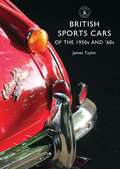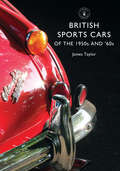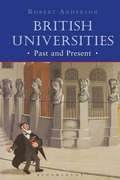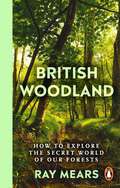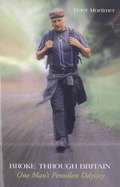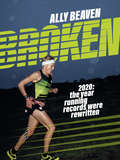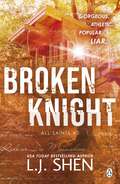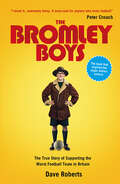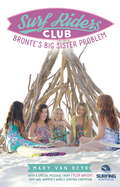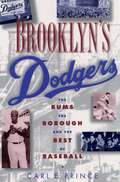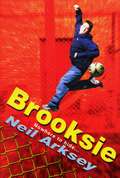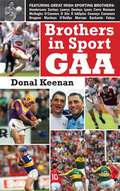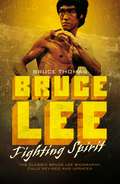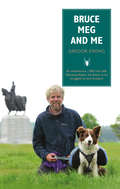- Table View
- List View
British Sport: Volume 1: Nationwide Histories
by Richard William CoxVolume one of a bibliography documenting all that has been written in the English language on the history of sport and physical education in Britain. It lists all secondary source material including reference works, in a classified order to meet the needs of the sports historian.
British Sport - a Bibliography to 2000: Volume 3: Biographical Studies of Britsh Sportsmen, Women and Animals
by Richard CoxVolume three of a bibliography documenting all that has been written in the English language on the history of sport and physical education in Britain. It lists all secondary source material including reference works, in a classified order to meet the needs of the sports historian.
British Sport - a Bibliography to 2000: Volume 3: Biographical Studies of Britsh Sportsmen, Women and Animals
by Richard William CoxVolume three of a bibliography documenting all that has been written in the English language on the history of sport and physical education in Britain. It lists all secondary source material including reference works, in a classified order to meet the needs of the sports historian.
British Sports Cars of the 1950s and ’60s (Shire Library)
by James TaylorE-type Jaguar; Triumph Spitfire; MGA; Austin-Healey – nobody built sports cars like British manufacturers in the 1950s and '60s. There was something very special about the combination of low-slung open two-seater bodywork and spartan interior, a slick sporting gearchange and a throaty exhaust note. This was wind-in-the-hair motoring, and it was affordable by the average young man – at least, until he got married and had a family. MG and Triumph stood out as the market leaders, but many other c companies thrived, from luxury manufacturers like Jaguar and even daimler to other more affordable marques. This colourfully illustrated history tells the exciting story of the British sports car in the 1950s and '60s.
British Sports Cars of the 1950s and ’60s (Shire Library #801)
by Mr James TaylorE-type Jaguar; Triumph Spitfire; MGA; Austin-Healey – nobody built sports cars like British manufacturers in the 1950s and '60s. There was something very special about the combination of low-slung open two-seater bodywork and spartan interior, a slick sporting gearchange and a throaty exhaust note. This was wind-in-the-hair motoring, and it was affordable by the average young man – at least, until he got married and had a family. MG and Triumph stood out as the market leaders, but many other c companies thrived, from luxury manufacturers like Jaguar and even daimler to other more affordable marques. This colourfully illustrated history tells the exciting story of the British sports car in the 1950s and '60s.
British Touring Car Racing: The crowd’s favourite - late 1960s to 1990 (Those were the days)
by Peter CollinsThis book is a brief but affectionate, mainly pictorial panorama of twenty-odd years of the British Touring Car Championship, from the anarchical 1960s and early 1970s of flared wheelarches, lifting wheels and smoking tyres, through the Group 1 years when the rule-makers tried to make the cars look standard and as a result, slow them down. This had the classic effect on racecar builders, who were not worth their salt unless they could get around the restrictions. The eventual results were faster cars than before, which evolved into the tarmac-melting, fire-breathing turbo powered front-runners of the late 1980s. The story stops at the point where the rule-makers tried another clampdown as the final decade of the 20th century dawned.
British Universities Past and Present
by Robert AndersonThis book is both a concise history of British universities and their place in society over eight centuries, and a penetrating analysis of current university problems and policies as seen in the light of that history. It explains how the modern university system has developed since the Victorian era, and gives special attention to changes in policy since the Second World War, including the effects of the Robbins report, the rise and fall of the binary system, the impact of the Thatcher era, and the financial crises which have beset universities in recent years. A final chapter on the past and the present shows the continuing relevance of the ideals inherited from the past, and makes an important contribution to current controversies by identifying a distinctively British university model and discussing the historical relationship of state and market.
British Universities Past and Present
by Robert AndersonThis book is both a concise history of British universities and their place in society over eight centuries, and a penetrating analysis of current university problems and policies as seen in the light of that history. It explains how the modern university system has developed since the Victorian era, and gives special attention to changes in policy since the Second World War, including the effects of the Robbins report, the rise and fall of the binary system, the impact of the Thatcher era, and the financial crises which have beset universities in recent years. A final chapter on the past and the present shows the continuing relevance of the ideals inherited from the past, and makes an important contribution to current controversies by identifying a distinctively British university model and discussing the historical relationship of state and market.
British Woodland: How to explore the secret world of our forests
by Ray MearsNobody sees and understands woodland better than Ray Mears.With deep natural history knowledge and practical woodcraft skills, gained over a lifetime of learning from the world's last remaining indigenous peoples, Ray offers a different way to experience our wooded landscapes. He challenges the old concepts. He looks to our ancestors and shows how man's hand in shaping woodland is critical. We are not separate from nature, we just need to ensure that our interactions have a positive impact.With the emphasis on interaction, British Woodland is structured by usage. We learn that sycamore and clematis are among the best woods for burning, pine and oak help us navigate, and hawthorn and beech have edible leaves. Rope can be made from willow, utensils and tools from hazel, and historically, weapons were made from yew and wych elm.With Ray as our guide, encouraging this sense of connection to individual trees, our appreciation of wooded landscapes will change. We can learn how to live inclusively in nature, for our own wellbeing and enjoyment, and also for the future of our planet.
Broke Through Britain: One Man's Penniless Odyssey
by Peter MortimerDuring the summer of 1998, Peter Mortimer set off on the 500-mile journey from Plymouth to Edinburgh, accompanied only by his King Charles spaniel. He took no money and had no transport or pre-arranged accommodation. Bereft of the basics necessary for human existence, such as food and shelter, he was dependent for his survival on his own wits, the generosity of others and good fortune.
Broken: 2020: the year running records were rewritten
by Ally Beaven‘The emotional pain of failing just felt like it was going to be a bit worse than the physical pain of carrying on … ’Attempting to break long-distance running records used to be an underground endeavour, until the virus-stricken summer of 2020 came along. Only a few, such as the Bob Graham Round in the Lake District, had ever broken into mainstream consciousness. But an absence of running races thanks to the Covid-19 pandemic resulted in an unprecedented rise in the popularity of attempts at breaking these records.In Broken, Ally Beaven takes an entertaining look at just why 2020 was so unusual for long-distance running. With his interest in Fastest Known Times (FKTs) piqued, Beaven immerses himself in the scene. His summer becomes one of spending hours in the hills feeding, cajoling and generally trying to keep safe the runners he is supporting, as well as following the dots of live trackers in the middle of the night and endlessly refreshing his Twitter feed as records tumble around the country.Through the stories of John Kelly’s epic Grand Round, Beth Pascall’s record-shattering Bob Graham Round, Donnie Campbell’s mind-bending new mark for bagging all 282 Munros, Jo Meek’s new overall record for the Nigel Jenkins Dartmoor Round and many others, Beaven brings us an inside look at the incredible FKT machine.Broken is the story of the summer of 2020, a historic time for running in the UK.
Broken Knight
by L. J. ShenNow #1 Amazon Bestseller in the entire Amazon store "Everyone needs to read this book. I’m certain you won’t feel a single regret. " - Harloe Rae, USA Today Bestselling author.From Wall Street Journal, USA Today, Washington Post bestselling author L.J. Shen comes a new, standalone romance about first loves, betrayal and loss.Not all love stories are written the same way. Ours had torn chapters, missing paragraphs, and a bittersweet ending.Luna Rexroth is everyone’s favorite wallflower. Sweet. Caring. Charitable. Quiet. Fake. Underneath the meek, tomboy exterior everyone loves (yet pities) is a girl who knows exactly what, and who, she wants—namely, the boy from the treehouse who taught her how to curse in sign language. Who taught her how to laugh. To live. To love.Knight Cole is everyone’s favorite football hero. Gorgeous. Athletic. Rugged. Popular. Liar. This daredevil hell-raiser could knock you up with his gaze alone, but he only has eyes for the girl across the street: Luna.But Luna is not who she used to be. She doesn’t need his protection anymore. When life throws a curveball at All Saints’ golden boy, he’s forced to realize not all knights are heroes. Sometimes, the greatest love stories flourish in tragedy.
Bromance: Male Friendship, Love and Sport
by Stefan Robinson Eric AndersonUnraveling the stereotype that men’s friendships are unemotional and shallow, this book provides the first detailed account of the bromance that exists among young men. Drawing on one year of ethnography and 20 in-depth interviews among a university sport team, the authors show that these men reject traditional masculine boundaries, instead prioritizing an emotional and tactile form of friendship. Chapters detail the cultural shift in society’s views on bromances, showing that bromances exists as an elevated, more emotional and intimate form of friendship, existing as a further positive consequence of decreasing cultural homophobia. By focusing on sport—which has traditionally been seen as a homophobic environment with toxic constructions of manhood—the authors show that even in the most traditionally masculine of settings, young men are rethinking what male friendship looks like, what it means to be a man, and the positive impact this can have on their mental health. This book will be relevant to a number of audiences including scholars and students in masculinity studies, queer studies, and friendship studies; LGBTQ+ activists and allies with interest in straight men’s friendships and sports cultures; and men’s mental health advocates.
The Bromley Boys: The True Story Of Supporting The Worst Football Club In Britain
by Dave RobertsThe book that inspired the major motion picture 'I loved it … extremely funny. A must-read for anyone who loves football.' Peter Crouch
Bronte's Big Sister Problem: Surf Riders Club Book 2 (Surf Riders Club #2)
by Mary Van ReykThe Surf Riders Club is back! And Bronte has a problem - a big sister problem! How's Bronte supposed to catch waves when she keeps fighting with her big sister? She always wanted to be just like Carrie, but now they are growing apart. Bronte wants to do her own thing, but Carrie thinks Surf Riders Club is lame.Now Bronte is torn between her friends and her sister. Will she get it together in time for the Beachcrest Carnival surf comp? Ava, Alex, Bronte, Janani and Molly formed Surf Riders Club to help each other practise, but it has quickly become much more than that. Whether it's learning how to get barrelled, problem parents or annoying boys, Surf Riders Club are there for each other, no matter what. Officially endorsed by Surfing Australia and includes a special message from Tyler Wright, 2016 WSL Women's World Surfing Champion.'kicks off in a very promising manner . . . Highly recommended for upper primary/early secondary readers.'- Just So Stories on SURF RIDERS CLUB 1: AVA'S BIG MOVE
Bronze Rules (Football Superstars #2)
by Simon MugfordFilled with quizzes, stats and little-known facts, plus illustrated and told with all the fun of a Tom Gates novel, the Football Superstars series is perfect for young readers five and up. Is Lucy Bronze your ultimate football heroine? The current England lionesses vice-captain is a three-time Women's Champions League champion with superclub Lyon. She is a two-time French League winner and also earned third place for England at the Women's World Cup in 2015.Playing in her best position as a roving right-back, Bronze loves to get forward on the pitch and has scored some sensational volleys in huge matches for club and country! Her story is one of defying the odds: she overcame career-threatening knee injuries and was told she would never again play for England to become one of the finest and most-decorated English players in women's football. An inspiration to young girls and boys alike.The Football Superstars series is aimed at building a love of reading from a young age, with fun cartoons, inspirational stories, a simple narrative style and a cast of characters chipping in with quotes, jokes and comments.
Brooklyn's Dodgers: The Bums, the Borough, and the Best of Baseball, 1947-1957
by Carl E. PrinceDuring the 1952 World Series, a Yankee fan trying to watch the game in a Brooklyn bar was told, "Why don't you go back where you belong, Yankee lover?" "I got a right to cheer my team," the intruder responded, "this is a free country." "This ain't no free country, chum," countered the Dodger fan, "this is Brooklyn." Brooklynites loved their "Bums"--Pee Wee Reese, Jackie Robinson, Duke Snider, Roy Campanella, and all the murderous parade of regulars who, after years of struggle, finally won the World Series in 1955. One could not live in Brooklyn and not catch its spirit of devotion to its baseball club. In Brooklyn's Dodgers, Carl E. Prince captures the intensity and depth of the team's relationship to the community and its people in the 1950s. Ethnic and racial tensions were part and parcel of a working class borough; the Dodgers' presence smoothed the rough edges of the ghetto conflict always present in the life of Brooklyn. The Dodger-inspired baseball program at the fabled Parade Grounds provided a path for boys that occasionally led to the prestigious "Dodger Rookie Team," and sometimes, via minor league contracts, to Ebbets Field itself. There were the boys who lined Bedford Avenue on game days hoping to retrieve home run balls and the men in the many bars who were not only devoted fans but collectively the keepers of the Dodger past--as were Brooklyn women, and in numbers. Indeed, women were tied to the Dodgers no less than their husbands, fathers, brothers, and sons; they were only less visible. A few, like Pulitzer Prize-winning poet Marianne Moore and working class stiff Hilda Chester were regulars at Ebbets Field and far from invisible. Prince also explores the underside of the Dodgers--the "baseball Annies," and the paternity suits that went with the territory. The Dodgers' male culture was played out as well in the team's politics, in the owners' manipulation of Dodger male egos, opponents' race-baiting, and the macho bravado of the team (how Jackie Robinson, for instance, would prod Giants' catcher Sal Yvars to impotent rage by signaling him when he was going to steal second base, then taunting him from second after the steal). The day in 1957 when Walter O'Malley, the owner of the Brooklyn Dodgers, announced that the team would be leaving for Los Angeles was one of the worst moments in baseball history, and a sad day in Brooklyn's history as well. The Dodger team was, to a degree unmatched in other major league cities, deeply enmeshed in the life and psyche of Brooklyn and its people. In this superb volume, Carl Prince illuminates this "Brooklyn" in the golden years after the Second World War.
Brooklyn's Dodgers: The Bums, the Borough, and the Best of Baseball, 1947-1957
by Carl E. PrinceDuring the 1952 World Series, a Yankee fan trying to watch the game in a Brooklyn bar was told, "Why don't you go back where you belong, Yankee lover?" "I got a right to cheer my team," the intruder responded, "this is a free country." "This ain't no free country, chum," countered the Dodger fan, "this is Brooklyn." Brooklynites loved their "Bums"--Pee Wee Reese, Jackie Robinson, Duke Snider, Roy Campanella, and all the murderous parade of regulars who, after years of struggle, finally won the World Series in 1955. One could not live in Brooklyn and not catch its spirit of devotion to its baseball club. In Brooklyn's Dodgers, Carl E. Prince captures the intensity and depth of the team's relationship to the community and its people in the 1950s. Ethnic and racial tensions were part and parcel of a working class borough; the Dodgers' presence smoothed the rough edges of the ghetto conflict always present in the life of Brooklyn. The Dodger-inspired baseball program at the fabled Parade Grounds provided a path for boys that occasionally led to the prestigious "Dodger Rookie Team," and sometimes, via minor league contracts, to Ebbets Field itself. There were the boys who lined Bedford Avenue on game days hoping to retrieve home run balls and the men in the many bars who were not only devoted fans but collectively the keepers of the Dodger past--as were Brooklyn women, and in numbers. Indeed, women were tied to the Dodgers no less than their husbands, fathers, brothers, and sons; they were only less visible. A few, like Pulitzer Prize-winning poet Marianne Moore and working class stiff Hilda Chester were regulars at Ebbets Field and far from invisible. Prince also explores the underside of the Dodgers--the "baseball Annies," and the paternity suits that went with the territory. The Dodgers' male culture was played out as well in the team's politics, in the owners' manipulation of Dodger male egos, opponents' race-baiting, and the macho bravado of the team (how Jackie Robinson, for instance, would prod Giants' catcher Sal Yvars to impotent rage by signaling him when he was going to steal second base, then taunting him from second after the steal). The day in 1957 when Walter O'Malley, the owner of the Brooklyn Dodgers, announced that the team would be leaving for Los Angeles was one of the worst moments in baseball history, and a sad day in Brooklyn's history as well. The Dodger team was, to a degree unmatched in other major league cities, deeply enmeshed in the life and psyche of Brooklyn and its people. In this superb volume, Carl Prince illuminates this "Brooklyn" in the golden years after the Second World War.
Brooksie
by Neil ArkseyImagine having a Premier league and England striker as your dad! Lee Brooks loves it, until his dad - 'Brooksie' - loses form and goes downhill embarrassingly fast. Lee hates Brooksie for letting him down. And Lee hates having to move to a grotty new home without his dad. With his own on-pitch confidence at an all-time low, he even begins to hate football. But then he meets Dent and his mates and the chance is there for him to play again - with a team of seriously talented players. They've just one problem - no pitch!
Brothers in Sport GAA: GAA Family Dynasties (Brothers In Sport Ser.)
by Donal KeenanIn a game rich with sibling talent and ability, Donal Keenan offers a fascinating examination of some of the game's remarkable family relationships. Profiling some of Ireland's most famous hurling and football brothers, Brothers in Sport provides an insight into the lives of these well-known sporting brothers. Including interviews with the Ó hAilpíns, the Earleys and the Canavans, as well as memories of past heroes like the Foleys and the Rackards, these profiles reflect the triumphs and disappointments of sporting brothers from across the country throughout their careers.
Brothers in Sport GAA: GAA Family Dynasties
by Donal KeenanIn a game rich with sibling talent and ability, Donal Keenan offers a fascinating examination of some of the game's remarkable family relationships. Profiling some of Ireland's most famous hurling and football brothers, Brothers in Sport provides an insight into the lives of these well-known sporting brothers. Including interviews with the Ó hAilpíns, the Earleys and the Canavans, as well as memories of past heroes like the Foleys and the Rackards, these profiles reflect the triumphs and disappointments of sporting brothers from across the country throughout their careers.
Bruce Lee: The Life of a Legend
by Fiaz RafiqLabels such as ‘icon’ or ‘legend’ are rarely attached to one individual to the degree that they are to Bruce Lee. He only made a handful of films, yet four and a half decades after his untimely death at the age of 32, the Little Dragon’s influence on culture is as strong as ever. Named among Time magazine’s 100 most influential people of the 20th century, Lee wasn’t just an actor and martial artist, but a director, inventor, husband, father and philosopher. His martial art, jeet kune do, is still practised around the world, while UFC champions credit him with inspiring the growing sport of mixed martial arts. His films kick-started a global kung fu boom and retain the power to awe today, while his thoughts – collected in a series of books from Lee’s own notes – still inspire.Bruce Lee: The Life of a Legend is a unique oral biography that combines the memories of Lee’s original students, close friends, co-stars and colleagues – those who knew him best – to provide a candid view on the action movie star adored by millions, capturing the essence of a complex man in a way no straightforward narrative ever could. Further, for the first time ever in print, legendary professional boxing, bodybuilding and MMA champions and personalities from the motion picture industry pay homage to Lee, giving a blend of unique perspectives on a man who changed the face of their respective sports.
Bruce Lee: Fighting Spirit
by Bruce ThomasIn the 1970s Bruce Lee emerged as the world's greatest fighting star - an accolade he has kept ever since. He battled to succeed in America in spite of the racial prejudice that denied him a starring role, eventually making films in Hong Kong that turned him into a star - the highest-paid movie star of his day. His controversial death, at the age of thirty-two when he was at the height of his powers, has given him a James-Dean style enduring appeal. In Bruce Lee - Fighting Spirit, Bruce Thomas has written a complete account not only of Lee's life and death, but of the fighting philosophy he developed (jeet kune do) which made him the greatest exponent of martial arts in modern times. In this updated edition he reassesses Lee's skills and examines the enduring impact of his legacy - on action films and martial arts today. As an icon Bruce Lee's popularity continues to grow and this book is a fitting tribute to an extraordinary man whose achievements have never been surpassed. 'An endlessly stimulating accout of Lee's life and times' Loaded
Bruce, Meg and Me: An adventurous 1,000 mile walk following Robert the Bruce as he struggled to save Scotland
by Gregor EwingCraving an escape from everyday life, Gregor Ewing writes a personal account of his 1,000 mile walk over nine weeks with collie Meg that takes them through Northern Ireland and the central belt of Scotland, literally following in Robert the Bruce’s footsteps. From Kintyre, Arran and Ardrossan north to Ayr through Glasgow to Fort William and Elgin, south to Inverurie, Aberdeen and Dundee, over the Forth to Edinburgh and Berwick upon Tweed then east through Roxburghshire to Bannockburn, Gregor frames his expedition with historical background that follows Robert the Bruce’s journey to start a campaign which led to his famous victory seven years later.
Brutal: My Autobiography
by Iwan Thomas'Lays bare the realities of a sporting career'Lord Sebastian Coe'Gripping, revealing and honest'Steve Cram OBE'A gripping read ... Iwan runs and runs and runs, and arrives at himself'Jeremy VineRunning has been Iwan Thomas's life. He put everything into becoming and remaining an elite athlete to such a point that his efforts left him scarred.Iwan reveals the highs of his career, but also his battles with the dark side of running – the loneliness, the doubts, the hurt and, ultimately, the serious mental health issues. After a youthful stint as a world-class BMX rider, Iwan dedicated himself to running. Between 1995 and 1998, he became one of the world's fastest men, taking silver in the 4x400m at the Olympics and gold at the European and World Championships. Yet, although his British 400m record of 44.36s would stand unbroken for 25 years, niggling injuries were already beginning to limit his ability to compete with the best. His response to setbacks had always been to train even harder, but this was no longer an option. Without the structure of training, the motivation of competition and the buzz of race day, Iwan struggled. He suffered an extended period of anxiety and depression, before eventually coming to terms with his life as a former athlete. In this deeply reflective, utterly engaging and sensationally open book, Iwan shares an absorbing, sometimes uncomfortable, but totally memorable story, and finally reveals the truth behind his life in sport.


